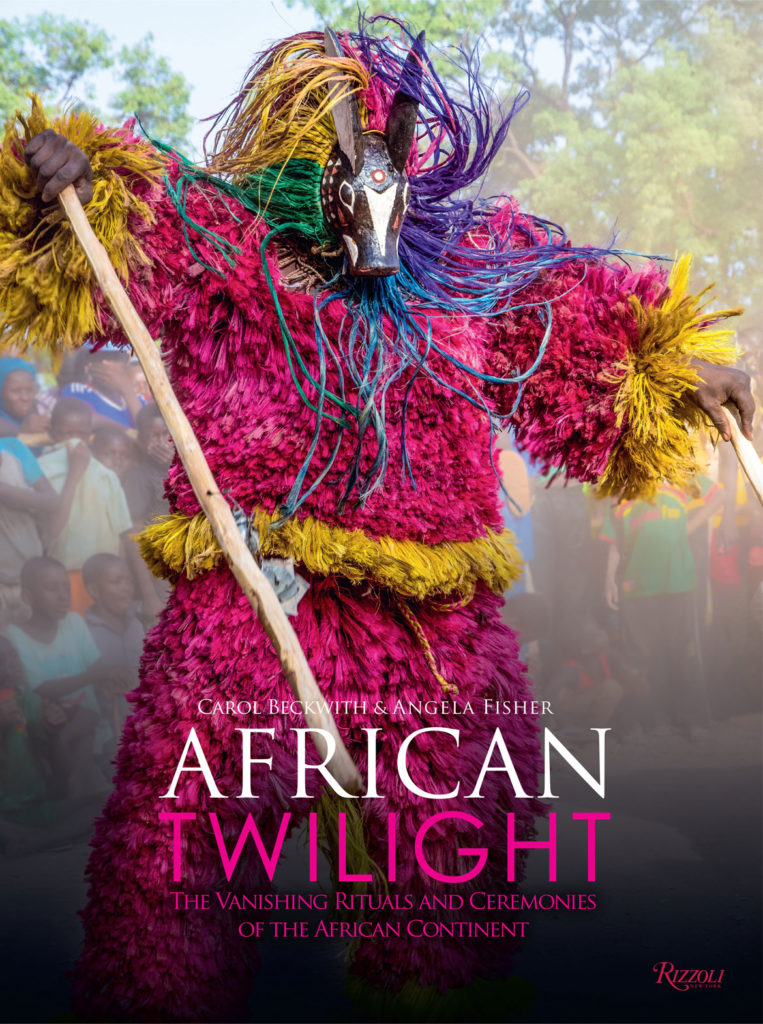For four decades, American born Carol Beckwith and Australian Angela Fisher have journeyed over 300,000 miles across the African continent, travelling through 44 countries to document more than 150 traditional tribal cultures. They photographed with astonishing access, empathy and artistry—as seen in their monumental, two-volume 2018 book, “African Twilight” (Rizzoli).
They’ll speak about “African Twilight: Vanishing Ceremonies of the African Continent” at Harvard University’s Center for African Studies Lounge, 1280 Massachusetts Ave., 3rd floor, Cambridge, on Thursday, Dec. 5, 2019, at 4 p.m.

“African Twilight” is a companion to their landmark, two-volume 1999 book “African Ceremonies,” a breathtaking photographic study of 93 dazzling ceremonies, rituals and rites of passage from birth to death across 26 countries. “African Twilight” continues this documentary effort. This time they spent 15 years traveling to remote communities to record Maasai warrior initiations in Tanzania, courtship rituals of the Ariaal of Kenya, masquerades of the spirit world in Burkina Faso, royal rituals of the Kuba Kingdom in DR Congo.
“The rituals we saw as well as the costumes, jewelry, and adornments have evolved over just a few decades into unrecognizable forms—or have vanished altogether—as Africans, like most people, move inexorably toward a more urbanized and technology-connected existence,” they write in the book’s introduction.

Beckwith, who began as a painter, was working on her first book, “Maasai” (1980), when her father gave her a balloon ride over the Maasai Mara for her birthday. As they recall in the book’s afterword, “At one thousand feet [the pilot] Simon looked deeply into Carol’s eyes and said, ‘There’s something I really want to tell you.’ Carol’s heart beat rapidly. Simon continued, still gazing into her eyes, ‘I’d really like you to meet my sister…’”
A year later, in Nairobi in 1978, Beckwith met that sister, Angela Fisher, at an exhibition of jewelry she had designed. “We soon realized Simon was right,” they write. “We were kindred spirits—nomads at heart—and shared a deep passion for the traditional cultures, art forms, and peoples of the continent.”
“In the early years, working with the Maasai of East Africa, we had no idea that we were going to spend the rest of our lives crisscrossing the continent, photographing traditional ceremonies and producing books,” they write in the introduction.

Their publications include “Nomads of Niger” (1983), “Africa Adorned” (1984), “African Ark” (1990), “African Ceremonies” (1999), “Passages” (2000), “Faces of Africa” (2004), “Lamu: Kenya’s Enchanted Island” (2009), “Dinka” (2010), Painted Bodies” (2012).
“For this book some of the most challenging journeys were in the DR Congo, where we lost our guide and translator,” Beckwith and Fisher write in the afterword. “Due to broken bridges, we were forced to leave our vehicle behind and to continue on motor bikes and dugout canoes in order to record the Salampasu ceremonies near the Angolan border. In Somaliland we traveled 300 miles to record a traditional desert wedding. The Somali government insisted that we take two vehicles of armed guards to protect us from al-Shabab terrorists who might cross the border in pursuit of our vehicles.”
Beckwith and Fisher say that 40 percent of what have recorded over the last four decades no longer exists.
“As Africa enters the twenty-first century, we believe the traditional values that bring a sense of well-being and fulfillment should be held on to,” they write in the afterword. “These would include respect for the wisdom of elders—the benefit of knowledge passed from one generation to another—the importance of the community for support, the value of rites and passages that define and teach us what is expected at each stage of life, and the maintaining of rituals that keep us in balance with nature and our environment.”
If this is the kind of coverage of arts, cultures and activisms you appreciate, please support Wonderland by contributing to Wonderland on Patreon. And sign up for our free, weekly newsletter so that you don’t miss any of our reporting.


![In Nigeria, "Seated on his throne, the Oba [or king] is surrounded by his three wives (right), the Ewaise chief (left), and royal courtiers (far left)," Carol Beckwith and Angela Fisher write in "African Twilight: The Vanishing Rituals and Ceremonies of the African Continent," 2018. (Rizzoli)](https://gregcookland.com/wonderland/wp-content/uploads/2019/12/AfricanTwilight_Book2_p060-061w-1024x719.jpg)

![The Rendille of northern Kenya’s Kaisut Desert: "Throughout the [Herr Heroon, or bull] ceremony, warriors gather in small groups to perform leaping dances, expressing their unity as a generation. When two warriors leap together the dance is called woyee," Carol Beckwith and Angela Fisher write in "African Twilight: The Vanishing Rituals and Ceremonies of the African Continent," 2018. (Rizzoli)](https://gregcookland.com/wonderland/wp-content/uploads/2019/12/AfricanTwilight_Book1_p111w-1024x711.jpg)
!["Performing the courtship dance, young Kara men [of Ethiopia’s Omo River valley] form long lines and leap high in the air to impress the admiring young women," Carol Beckwith and Angela Fisher write in "African Twilight: The Vanishing Rituals and Ceremonies of the African Continent," 2018. (Rizzoli)](https://gregcookland.com/wonderland/wp-content/uploads/2019/12/AfricanTwilight_Book1_p446-447w-1024x702.jpg)

![The Rendille of northern Kenya’s Kaisut Desert: "Throughout the [Herr Heroon, or bull] ceremony, warriors gather in small groups to perform leaping dances, expressing their unity as a generation. When two warriors leap together the dance is called woyee," Carol Beckwith and Angela Fisher write in "African Twilight: The Vanishing Rituals and Ceremonies of the African Continent," 2018. (Rizzoli)](https://gregcookland.com/wonderland/wp-content/uploads/2019/12/AfricanTwilight_Book1_p111w530.jpg)